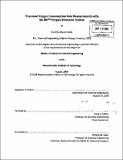| dc.contributor.advisor | Clark K. Colton. | en_US |
| dc.contributor.author | Low, Clarke Alan | en_US |
| dc.contributor.other | Massachusetts Institute of Technology. Dept. of Chemical Engineering. | en_US |
| dc.date.accessioned | 2009-06-30T16:38:30Z | |
| dc.date.available | 2009-06-30T16:38:30Z | |
| dc.date.copyright | 2008 | en_US |
| dc.date.issued | 2008 | en_US |
| dc.identifier.uri | http://hdl.handle.net/1721.1/45922 | |
| dc.description | Thesis (S. M.)--Massachusetts Institute of Technology, Dept. of Chemical Engineering, 2008. | en_US |
| dc.description | In title on title page, double-underscored "TM" appears as superscript . | en_US |
| dc.description | Includes bibliographical references (p. 109-111). | en_US |
| dc.description.abstract | Oxygen consumption rate (OCR) is a reliable indicator of tissue health. Recently, the OCR of isolated human islets has been shown to predict transplant outcome in diabetic mice. The Oxygen Biosensor System (OBS) is a high-throughput, convenient assay that indirectly measures oxygen consumption by measuring oxygen partial pressure, pO2, adjacent to tissue loaded into the OBS multiwell plate. Solving the general species transport equations for a steady-state solution has not accurately converted pO₂ measurements to OCR. Furthermore, the time to reach steady-state is prohibitively long (at least 5 hr). Transient OBS experiments have been conducted and the rate of p02 change has been shown to correlate with the amount of viable tissue, however, no direct relation with OCR has been established. The overall objective of this thesis was to accurately measure OCR using transient OBS measurements. I fabricated flat OBS plates to simplify the geometry for theoretical models, but theoretical simulations did not match well with experimental data. Furthermore, fabricated flat OBS plates did not behave experimentally as would be expected from I-D, slab geometry. Simplified theoretical models were developed to qualitatively understand the effects of silicone rubber thickness, medium volume, and OCR density on the transient behavior of the OBS. It was shown that medium volume and OCR density should be increased as much as well-volume and tissue constraints allow. Commercial OBS plates were used for subsequent experiments, so it was unable to actively control silicone rubber thickness. Transient OBS measurements with both INS-1 cells and islets were correlated with stirred chamber OCR measurements conducted in parallel. The two measurements were linearly related and a calibration curve was developed so that OBS transient measurements could be converted to OCR. The relationship between the two measurements were similar enough for both cells and islets that the calibration curve seems to be independent of tissue geometry. | en_US |
| dc.description.abstract | (cont.) Increased variability of islet tissue caused greater uncertainty about the islet prediction curve. This variability was compared with stirred chamber islet variability and islet sampling is hypothesized to be the underlying cause of high measurement variability with islets. | en_US |
| dc.description.statementofresponsibility | by Clarke Alan Low. | en_US |
| dc.format.extent | 111 p. | en_US |
| dc.language.iso | eng | en_US |
| dc.publisher | Massachusetts Institute of Technology | en_US |
| dc.rights | M.I.T. theses are protected by
copyright. They may be viewed from this source for any purpose, but
reproduction or distribution in any format is prohibited without written
permission. See provided URL for inquiries about permission. | en_US |
| dc.rights.uri | http://dspace.mit.edu/handle/1721.1/7582 | en_US |
| dc.subject | Chemical Engineering. | en_US |
| dc.title | Transient oxygen consumption rate measurements with the BDT̳M̳ oxygen biosensor system | en_US |
| dc.type | Thesis | en_US |
| dc.description.degree | S.M. | en_US |
| dc.contributor.department | Massachusetts Institute of Technology. Department of Chemical Engineering | |
| dc.identifier.oclc | 320775910 | en_US |
